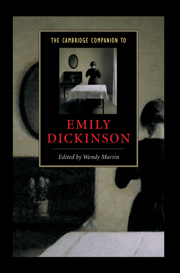Book contents
- Frontmatter
- Introduction
- Part 1 Biography and publication history
- Part 2 Poetic strategies and themes
- 4 Emily Dickinson and poetic strategy
- 5 Emily Dickinson’s existential dramas
- 6 Performances of gender in Dickinson’s poetry
- 7 Emily Dickinson
- 8 Emily Dickinson and the Gothic in Fascicle 16
- Part 3 Cultural contexts
- Select bibliography
- Index
7 - Emily Dickinson
being in the body
from Part 2 - Poetic strategies and themes
Published online by Cambridge University Press: 28 May 2006
- Frontmatter
- Introduction
- Part 1 Biography and publication history
- Part 2 Poetic strategies and themes
- 4 Emily Dickinson and poetic strategy
- 5 Emily Dickinson’s existential dramas
- 6 Performances of gender in Dickinson’s poetry
- 7 Emily Dickinson
- 8 Emily Dickinson and the Gothic in Fascicle 16
- Part 3 Cultural contexts
- Select bibliography
- Index
Summary
I am afraid to own a Body -
I am afraid to own a Soul -
Profound - precarious Property -
Possession, not optional -
Double Estate - entailed at pleasure
Upon an unsuspecting Heir -
Duke in a moment of Deathlessness
And God, for a Frontier.
(J 1090/Fr 1050)In this poem Emily Dickinson seems at her furthest remove from Walt Whitman. His “I am the poet of the Body and I am the poet of the Soul . . . The first I graft and increase upon myself, the latter I translate into a new tongue” (Song 21) in its inclusive, expansive energy poses the most extreme counterpoint to Dickinson's exclusions, retractions, and renunciations. I wish to argue, however, that Dickinson’s work addresses cultural forces and challenges in ways continuous with Whitman’s, although ultimately with a difference in cultural position from his, that remains fundamental.
- Type
- Chapter
- Information
- The Cambridge Companion to Emily Dickinson , pp. 129 - 141Publisher: Cambridge University PressPrint publication year: 2002
- 5
- Cited by

